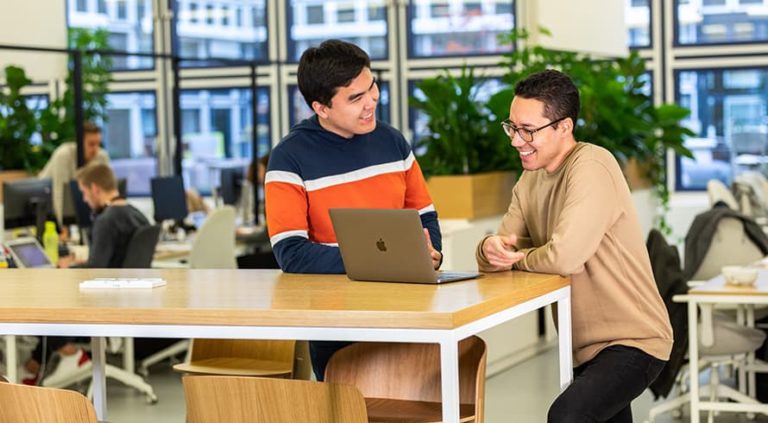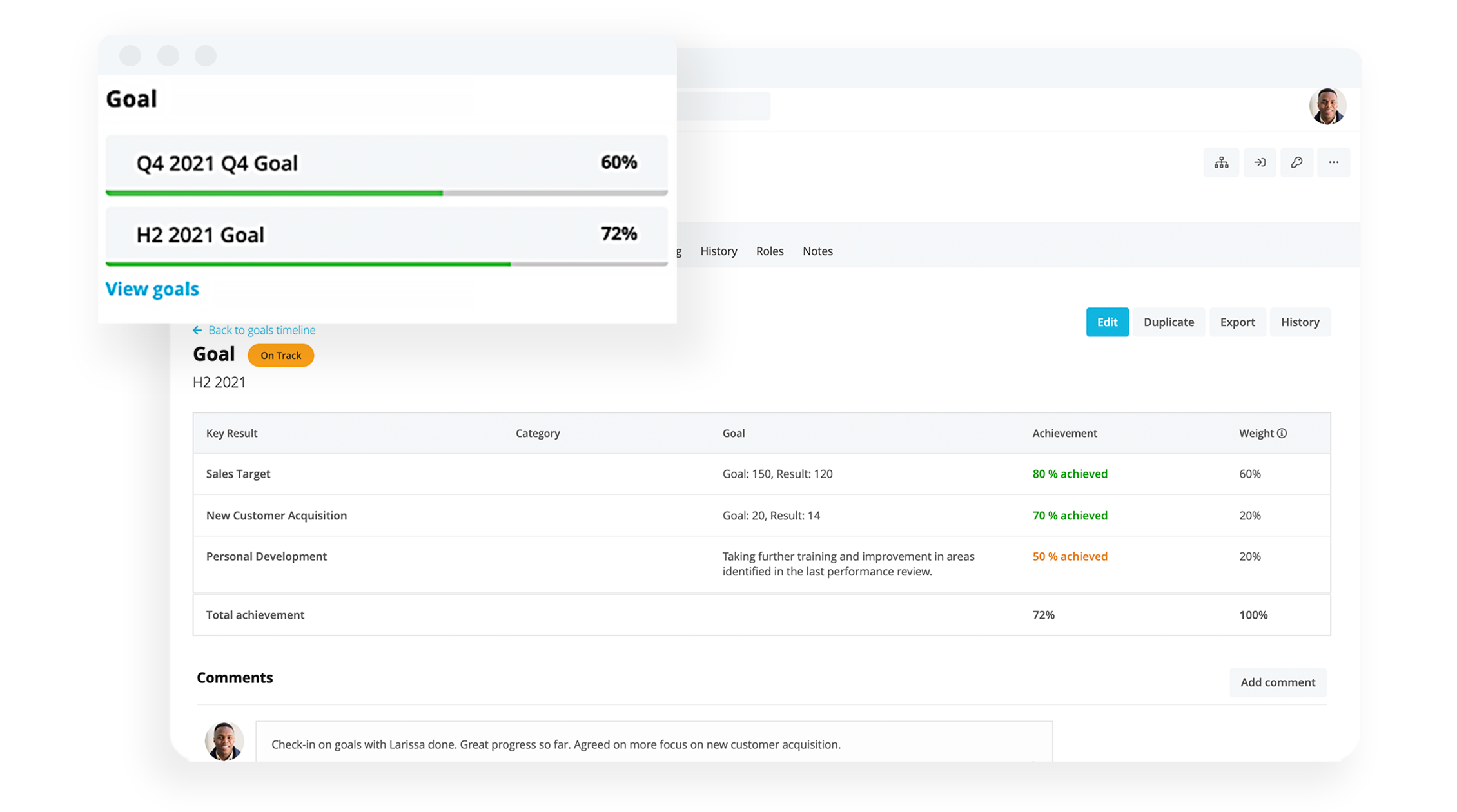
Streamline Your Feedback Cycles
Exchange fair, actionable feedback, company-wide.
Transform Your Feedback CyclesThe 10 Guidelines for Great Constructive Feedback

When it comes to constructive feedback for HR leaders, it all comes down to performance. After all, everyone agrees that feedback is one of the most valuable parts of any staff appraisal or performance management cycle.
In addition, it is critical to an employee's continuous professional development. So, why is it still such a hot topic for discussion? It’s because the process of determining when and how to give feedback is not a science, but an art.
What Is Constructive Feedback?
Constructive feedback is useful information or suggestions given to team members to help them achieve a productive outcome. It is specific, based on observation, and directed in a positive light toward an employee’s performance, skills, behaviour, or ability to work with others.
When Do You Give Constructive Feedback?
Feedback can be given formally (as part of regular feedback rounds in a performance management cycle, for example) or informally, when the need or opportunity arises.
How Do You Give Constructive Feedback?
The most important thing to remember about constructive feedback is this: The ultimate goal is to empower employees to develop skills. It lets them know where they stand in relation to the expectations for their current role (and future role).
Do Employees Like Constructive Feedback?
Talented people want to do their jobs effectively and grow professionally. Feedback is one of the main tools to nurture both of these aims. Whether it is praise or criticism, feedback should always support these.
Why Does Constructive Feedback Matter?
Ultimately, the result of a company-wide feedback process is a positive, motivated workforce. That benefits everyone, especially the company.
Click here to read about the ten most important people management skills for your org.
Ongoing Feedback That Drives Top Talent

Personio’s Performance Management function allows employees to answer questions and provide feedback on their own work, and for managers to do the same. Check it out today by clicking the button below.
Scaling Feedback With PersonioHow Do You Know When Employees Need Constructive Feedback?
Studies show time and again that employees care about getting feedback. Some surveys even show that nearly all employees (96%) think it is important, and over 80% say they appreciate feedback. This is true even when it’s negative feedback, which can rate as even more important.
It’s also clear that employees prefer feedback often, weekly, or at least monthly in many cases, and not just as part of scheduled performance reviews. Being able to check-in and receive guidance regularly boosts both confidence and overall employee engagement.
So, what’s the answer? It’s less productive to think about when an employee might need feedback, but how often you can give them feedback and what makes sense for your time. After all, an employee is almost always going to appreciate it. When it is delivered correctly, of course.
What About Managers?
Managers who give feedback receive high ratings, too. In one study, team leads who gave the right amount of feedback scored 8.5 out of 10, whereas those giving too little or too much had significantly lower scores.
Feedback benefits employee performance on two levels. The obvious one is that constructive feedback helps them do their jobs better and nurtures their continuous professional development.
Through feedback, employees can:
Learn how to improve at day-to-day tasks.
Better understand their strengths to develop them further.
Get a handle on which weaknesses to improve upon.
On a less noticeable, but equally as powerful level, constructive feedback also builds trust and stronger employee relations between managers and their direct reports.
It helps managers move from a ‘directing’ role to a ‘coaching’ role, whereby both parties work together toward a common outcome.
Constructive Feedback for Both Engagement and Retention
If we go beyond employees’ desire for frequent feedback, this communication channel also has an impact on employee engagement and retention rates. For many HR leaders, both of these are likely two of your largest challenges.
Research shows that team members who have regular meetings with their managers are three times more likely to be engaged at work compared to those who do not.
In that sense, positive feedback is a strong driver of engagement. In fact, employee engagement metrics trend three times higher for those employees who receive recognition, according to one large, international study.
Unsurprisingly, the same study showed that workers were twice as likely to quit if their work was not recognized or if there was not an employee recognition program in the first place.
Data backs up what you already know: employees want to know how they are doing, and often. If your company doesn’t have mechanisms in place to ensure they get this feedback, your valuable talent will move on.
What Is The Best Approach To Feedback?
For far too long, constructive feedback has been restricted to formal performance reviews, annually or, in the best cases, semi-annually. That kind of structured manager-to-employee feedback still has its place as part of a person’s professional development plan.
But far more useful are staff appraisals given on an ongoing basis. This requirement to give feedback should be built into a manager’s responsibilities: frequent formal check-ins as well as informal, ad-hoc feedback.
Feedback should be given at every key milestone or event that an employee is involved in. It allows them to better understand the impact of their performance (strong and weak) on business operations.
It’s also crucial to keeping up day-to-day motivation and productivity. The more recognized and supported an employee feels, the more likely that is to feature as a key employee retention strategy.
Loop Feedback Into Performance Management

Don’t deny the critical role that feedback can play in developing your top talent. Download our guide for more.
Download NowGuidelines for Giving Meaningful Constructive Feedback
The way your company organises feedback will depend on various factors, such as company size, culture, employee roles, etc. So, providing a feedback template is not necessarily useful here.
What is useful are guidelines to ensure these discussions will have an impact. This will ensure the ideal result for the company: motivated, engaged employees.
1. Focus On Outcomes
We mentioned this above, but it bears more attention. Constructive feedback is not about simple praise or criticism. Its purpose should be to achieve the desired outcome. That’s the starting point for formulating and sharing feedback.
Some examples of outcomes might be:
A change in behaviour (e.g. a chronically late employee starting to show up to work on time)
A continuation of the same excellent work
An increase in responsibilities
The manager’s role, then, is to provide feedback that moves the employee toward continuing what they have been doing. Or, alternatively, to change.
2. Share Feedback Based On Observations
Managers should be careful to separate opinion from observation when delivering feedback. Good feedback is based purely on the employee’s behaviour that the manager has observed.
It doesn’t matter if the manager believes an employee who is routinely late is lazy. Constructive feedback leaves those personal judgments or interpretations out: "I notice you were late two days so far this week, and I’m concerned because it’s having an impact on the workload of the rest of the team.”
Basically, the main thing to note is that managers should not jump to conclusions. Observable, empirical data is important, and it is okay to derive certain conclusions, but concluding someone’s character is not a productive place to start.
3. Be Highly Specific
Regardless of whether it’s positive or negative feedback, details matter. Employees need to understand exactly which actions are appreciated, or not, in order to do more of the same or correct what is not working.
Without details, feedback like “You’ve done a great job on this project,” sounds nice but doesn’t help. It might even be perceived as insincere. Instead, aim for specifics: “You managed the timeline and expectations well,” or “I like that you did weekly updates on the project deliverables,” or “You created an excellent way for all the stakeholders on the project to communicate.”
It’s the same for negative feedback. Instead of “I notice your work is often late,” an employee learns much more from a constructive feedback example like, “I notice that the project report for this month was due Friday, but I haven’t seen it. This happened the previous month also. That makes it hard for the exec team to track our performance goals. How can we work to improve this?”
This makes your feedback much more ‘real.’ Real in the sense that there are events directly connected to behaviour, so an employee can have a template to repeat that positive behaviour (and avoid repeating negative behaviours, as well). It also gives a roadmap for improvement, which as a leader is your responsibility, too.
4. Constructive Feedback Is Direct
Giving feedback may be uncomfortable at times (especially if it’s negative), but it does no good to beat around the bush. Managers should get to the point by stating key information in a straightforward manner.
Some HR experts used to advocate “the sandwich method” in which negative feedback is preceded and finished with positive feedback, in order to soften the blow.
This may sound okay, but it undermines trust. Employees will see through the insincerity and be more apt to tune out the real message (or, simply choose not to focus on it and instead pay attention only to the positive).
It is better to address the feedback head-on, using the delivery guidelines provided in this list. It will help make things more direct, more clear, and generally more engaging with an employee who hears it. Your message will resonate.
5. Avoid “You Need To” and “Yes, But” Language
Delivery is everything when giving feedback. While using language that focuses on observations (“I notice”, “I observed”, “I see”), managers should also avoid using certain phrases.
When managers begin feedback with, “you need to…” phrases (example: “You need to make your presentations shorter.”), it implies the employee has done something wrong and immediately puts the person on the defensive.
A simple shift to: “When you did your presentation today, I felt it was too long and had more detail than the audience needed” is more descriptive and is focused on actions, not the person.
Managers should also steer clear of mixed messages (aka “yes, but” messages) that mix positive and negative feedback: “You did a great job on the presentation today, but it was much too long.” These come off to employees as both confusing and fake — they are attempts to sugar-coat a negative reaction.
Again, straightforward is best.
6. Focus On Present, Past, and Future (In That Order)
This suggestion goes in hand with feedback that gets to the point. Constructive feedback, especially when it’s negative, works best when it flows in a certain order.
It should start with the present situation: What is the problem that needs to be addressed? In this situation, managers and employees should feel emboldened to explore what is or is not working right now.
After this, the feedback turns to the past:
Has this happened before?
What did the employee do or not do to help the situation?
This discussion can then naturally lead to the future, with questions about concrete steps to move forward in a successful way.
7. Celebrate ‘Mastery Moments’
One of the best ways managers can give positive feedback is when an employee excels at something. For instance, right after the person has nailed a presentation or satisfied an angry customer.
This is what is often referred to as a mastery moment. A moment wherein an employee exhibits mastery over a subject or a situation, and where they truly embodied what ideal performance looks like at your company.
This is the moment to:
Call out the achievement.
Give details on why this moment matters to the business.
Encourage more of this kind of excellence.
It only takes a few minutes to celebrate these victories, but the impact on employee motivation can last well after.
Give Top Talent The Attention They Deserve

By introducing a strategic performance management function that runs automated cycles, tracks goals, and gives feedback when it matters most. Discover Personio today.
Performance With Personio8. Give Feedback As Soon As Possible
Outside of feedback given during performance reviews, which may be months apart, it is good practice to deliver feedback as close to a performance incident as possible. That way, the details are fresh in everyone’s minds.
If the feedback is negative, it means the manager is hopefully addressing the problem before it can get out of hand. In the case of positive feedback, quick recognition can act as a powerful motivator.
That said, there is one caveat to timely feedback. Negative incidents can be upsetting. Managers may need to take some extra time to cool off and organise the appropriate feedback.
Therefore, it is often better to wait a day and ensure the feedback is truly constructive than to rush into a meeting with the employee and give criticism that doesn’t allow for any learning and progress.
9. Aim For Face-To-Face Feedback
Tone of voice and body language are part of delivering constructive feedback in a way that builds trust and achieves the best outcomes. That’s why it’s more effective to do face-to-face feedback rounds (virtually or in-person).
That being said, it’s also important to deliver feedback in a timely way (as in the previous point). So, if the fastest way to provide some informal, positive feedback on a job well done is via email or messaging, then managers should feel free to go for it.
That said, there is rarely a good substitute for face-to-face contact, especially when it comes to delivering constructive feedback and optimal performance management.
10. Take Diligent Notes
Managers need to keep accurate tabs on the feedback they have shared with employees rather than rely on memory.
This is particularly useful for performance reviews where promotions, raises, and professional development opportunities are discussed.
Sharing notes in these one-on-ones will help both sides see patterns and trends in achievements and behaviour that will make it easier to plan what comes next in an employee’s performance plan.
Constructive Feedback That Drives Performance
When it’s clear to employees that the aim of constructive feedback is to support their success in their current jobs and longer-term career, it is usually well-received, even when it’s negative.
Most employees will readily apply and learn from this information, and managers who really understand how to give feedback well are doing your business a valuable service by supporting engagement and retention.
